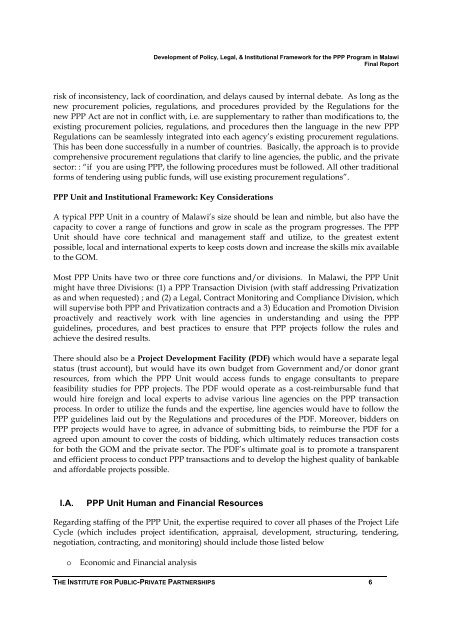Development of Policy, Legal, and Insitutional Framework for - ppiaf
Development of Policy, Legal, and Insitutional Framework for - ppiaf
Development of Policy, Legal, and Insitutional Framework for - ppiaf
You also want an ePaper? Increase the reach of your titles
YUMPU automatically turns print PDFs into web optimized ePapers that Google loves.
<strong>Development</strong> <strong>of</strong> <strong>Policy</strong>, <strong>Legal</strong>, & Institutional <strong>Framework</strong> <strong>for</strong> the PPP Program in Malawi<br />
Final Report<br />
risk <strong>of</strong> inconsistency, lack <strong>of</strong> coordination, <strong>and</strong> delays caused by internal debate. As long as the<br />
new procurement policies, regulations, <strong>and</strong> procedures provided by the Regulations <strong>for</strong> the<br />
new PPP Act are not in conflict with, i.e. are supplementary to rather than modifications to, the<br />
existing procurement policies, regulations, <strong>and</strong> procedures then the language in the new PPP<br />
Regulations can be seamlessly integrated into each agency’s existing procurement regulations.<br />
This has been done successfully in a number <strong>of</strong> countries. Basically, the approach is to provide<br />
comprehensive procurement regulations that clarify to line agencies, the public, <strong>and</strong> the private<br />
sector: : “if you are using PPP, the following procedures must be followed. All other traditional<br />
<strong>for</strong>ms <strong>of</strong> tendering using public funds, will use existing procurement regulations”.<br />
PPP Unit <strong>and</strong> Institutional <strong>Framework</strong>: Key Considerations<br />
A typical PPP Unit in a country <strong>of</strong> Malawi’s size should be lean <strong>and</strong> nimble, but also have the<br />
capacity to cover a range <strong>of</strong> functions <strong>and</strong> grow in scale as the program progresses. The PPP<br />
Unit should have core technical <strong>and</strong> management staff <strong>and</strong> utilize, to the greatest extent<br />
possible, local <strong>and</strong> international experts to keep costs down <strong>and</strong> increase the skills mix available<br />
to the GOM.<br />
Most PPP Units have two or three core functions <strong>and</strong>/or divisions. In Malawi, the PPP Unit<br />
might have three Divisions: (1) a PPP Transaction Division (with staff addressing Privatization<br />
as <strong>and</strong> when requested) ; <strong>and</strong> (2) a <strong>Legal</strong>, Contract Monitoring <strong>and</strong> Compliance Division, which<br />
will supervise both PPP <strong>and</strong> Privatization contracts <strong>and</strong> a 3) Education <strong>and</strong> Promotion Division<br />
proactively <strong>and</strong> reactively work with line agencies in underst<strong>and</strong>ing <strong>and</strong> using the PPP<br />
guidelines, procedures, <strong>and</strong> best practices to ensure that PPP projects follow the rules <strong>and</strong><br />
achieve the desired results.<br />
There should also be a Project <strong>Development</strong> Facility (PDF) which would have a separate legal<br />
status (trust account), but would have its own budget from Government <strong>and</strong>/or donor grant<br />
resources, from which the PPP Unit would access funds to engage consultants to prepare<br />
feasibility studies <strong>for</strong> PPP projects. The PDF would operate as a cost-reimbursable fund that<br />
would hire <strong>for</strong>eign <strong>and</strong> local experts to advise various line agencies on the PPP transaction<br />
process. In order to utilize the funds <strong>and</strong> the expertise, line agencies would have to follow the<br />
PPP guidelines laid out by the Regulations <strong>and</strong> procedures <strong>of</strong> the PDF. Moreover, bidders on<br />
PPP projects would have to agree, in advance <strong>of</strong> submitting bids, to reimburse the PDF <strong>for</strong> a<br />
agreed upon amount to cover the costs <strong>of</strong> bidding, which ultimately reduces transaction costs<br />
<strong>for</strong> both the GOM <strong>and</strong> the private sector. The PDF’s ultimate goal is to promote a transparent<br />
<strong>and</strong> efficient process to conduct PPP transactions <strong>and</strong> to develop the highest quality <strong>of</strong> bankable<br />
<strong>and</strong> af<strong>for</strong>dable projects possible.<br />
I.A.<br />
PPP Unit Human <strong>and</strong> Financial Resources<br />
Regarding staffing <strong>of</strong> the PPP Unit, the expertise required to cover all phases <strong>of</strong> the Project Life<br />
Cycle (which includes project identification, appraisal, development, structuring, tendering,<br />
negotiation, contracting, <strong>and</strong> monitoring) should include those listed below<br />
o<br />
Economic <strong>and</strong> Financial analysis<br />
THE INSTITUTE FOR PUBLIC-PRIVATE PARTNERSHIPS 6
















